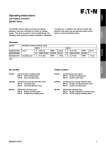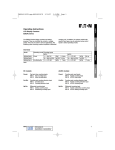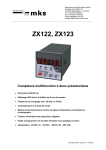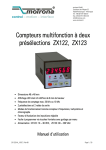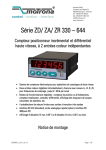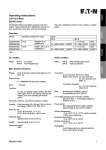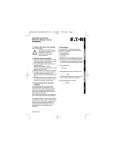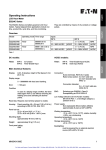Download ISI30/31/32/33 Betriebsanleitung Operating instructions Instructions
Transcript
ZÄHLER STEUERGERÄTE DREHGEBER english Operating instructions Instructions d´utilisation deutsch Betriebsanleitung français ISI30/31/32/33 IVO GmbH & Co. P.O. Box 3360 • D-78022 Villingen-Schwenningen Telefon +49 (0)7720 942-0 • Fax +49 (0)7720 942-900 www.ivo.de • e-mail: [email protected] 10.02171.55.256/1 171.55.256/1 10.02 Betriebsanleitung LCD-Anzeigezähler isiLine 30/31/32/33 Die isiLine Anzeigezähler sind batteriebetrieben. Die Ansteuerung erfolgt über potentialfreie Kontakte oder Spannungsimpulse. Sie lassen sich in unterschiedlichen Applikationen einsetzen, wie z.B. Summenzählung, Stückzählung, Positionserfassung, Differenzzählung usw. Die verschiedenen Typen mit spezifischen Eingangsarten lassen sich mittels Steuereingängen zusätzlich erweitetern und auf fast alle Anwendungen anpassen. Typenübersicht: Type Eingangsart ISI30.010AX01 Count Zähleingänge INP A ISI30.012AX01 ISI30.013AX01 ISI31.010AX01 INP B 00 ... 0,7 V DC NPN 07 kHz 00 ... 0,7 V DC NPN 04 ... 30 V DC PNP 12 kHz 00 ... 0,7 V DC NPN 10 ... 260 V AC/DC AC/DC 30 Hz Cnt.Dir/Up.Dn ISI31.011AX01 30 Hz 10 ... 260 V AC/DC AC/DC 0– 00 ... 0,7 V DC NPN 07 kHz 00 ... 0,7 V DC NPN 07 kHz 04 ... 30 V DC PNP 12 kHz 04 ... 30 V DC PNP 12 kHz ISI31.013AX01 Up.Dn 10 ... 260 V AC/DC AC/DC 30 Hz 10 ... 260 V AC/DC AC/DC 30 Hz ISI32.013AX01 Cnt.Dir 10 ... 260 V AC/DC AC/DC 30 Hz 10 ... 260 V AC/DC AC/DC 30 Hz ISI33.010AX01 Quad/Quad2 00 ... 0,7 V DC NPN 03 kHz 00 ... 0,7 V DC NPN 03 kHz 04 ... 30 V DC PNP 06 kHz 04 ... 30 V DC PNP 06 kHz ISI33.011AX01 Optionen: Tabelle 1 x = A: ohne Hintergrundbeleuchtung x = B: mit Hintergrundbeleuchtung Eingangsarten DC: Eingangsarten AC: Count: Schneller und langsamer Zähleingang INP A: Zähleingang schnell INP B: Zähleingang langsam Count: Zähl- und Rücksetzeingang INP A: Zähleingang AC/DC INP B: Rücksetzeingang AC/DC Cnt.Dir: Zähleingang und Zählrichtungseingang INP A: Zähleingang INP B: Zählrichtungseingang Cnt.Dir: Zähleingang und Zählrichtungseingang INP A: Zählrichtungseingang AC/DC INP B: Zähleingang AC/DC Up.Dn: Differenzzähleingang INP A: Zähleingang addierend INP B: Zähleingang subtrahierend Up.Dn: Differenzzähleingang INP A: Zähleingang subtrahierend AC/DC INP B: Zähleingang addierend AC/DC. Quad: Phasendiskriminatoreingang INP A: Zähleingang 0° INP B: Zähleingang 90° Quad2: Phasendiskriminatoreingang mit Impulsverdopplung INP A: Zähleingang 0° INP B: Zähleingang 90° Jede Flanke von INP A wird gezählt. 2 Allgemeine technische Daten: Anschluss: Schraubklemme, RM 5.00, 8 polig Nennquerschnitt: 4,0 mm2 eindrähtig 2,5 mm2 feindrähtig AWG 12 Anschlussdurchmesser: 0,4 ... 2,3 mm eindrähtig AWG 28-12 Anzeigebereich: -9999999 ... 99999999 mit Vornullenunterdrückung. Überlauf: Bei Überschreiten des Anzeigebereichs beginnt der Zähler wieder bei 0, jedoch ohne Vornullenunterdrückung und mit Ansteuerung aller Dezimalpunkte Bei Unterschreiten des Anzeigebereichs beginnt der Zähler wieder bei 0, jedoch mit gesetztem Minuszeichen, ohne Vornullenunterdrückung und mit Ansteuerung aller Dezimalpunkte. Tastatur: Resettaste elektrisch verriegelbar Störabstrahlung EN55011 Klasse B Störfestigkeit EN 61000-6-2 NSR (für AC-Typen): EN 61010 Teil 1; Überspannungskategorie 2, Verschmutzungsgrad 2 Spannungsversorgung: fest eingebaute Lithium-Batterie (ca. 8 Jahre bei 20°C) Gehäuse: Schalttafelgehäuse 48 x 24 mm nach DIN 43 700, Farbe RAL 7021 Arbeitstemperatur: –10 ... +55 °C, rel. Luftfeuchte < 85%, nicht kondensierend Betriebstemperatur: –10 ... +60 °C Lagertemperatur: –20 ... +70°C Schalttafelausschnitt: 22,2+0,3 x 45+0,6 mm Einbautiefe:ca. 48 mm Gewicht: EMV: ca. 50 g Schutzart: IP65 frontseitig Hintergrundbeleuchtung: externe Spannungsversrogung (24 V DC ±20 %, 50 mA) Eingangsspezifikation, Anschlussbelegung und einstellbare Betriebsarten (DC-Ausführungen) INP A INP B Nr. 3 Nr. 4 Nr. 5 Nr. 6 Nr. 7 Nr. 8 Reset Reset Enable Steuereingang für Betriebsart (Mode) unbeschaltet beschaltet nach GND = = addierend subtrahierend GND BL – BL + Hintergrundbeleuchtung (+) Bezeichnung Nr. 2 Hintergrundbeleuchtung (–) Schraubklemme Nr. 1 Verriegelungseingang für Rücksetztaste NPN. Beschaltet nach GND, Taste freigeschaltet. Über einen Steuereingang (Schraubklemme 5) wird die Betriebsart eingestellt. ISI30.010AX01 07 kHz NPN ISI30.012AX01 12 kHz PNP ISI31.010AX01 07 kHz NPN 07 kHz NPN ISI31.011AX01 12 kHz PNP 12 kHz PNP ISI33.010AX01 03 kHz NPN 03 kHz NPN ISI33.011AX01 06 kHz PNP 06 kHz PNP NPN NPN Rücksetzeingang NPN 30 Hz unbeschaltet = Cnt.Dr Mode beschaltet nach GND = Up.Dn Mode unbeschaltet = Quad Mode beschaltet nach GND = Quad2 Mode GND = 0 V DC Typ Tabelle 2 Schraubklemme 1 und 2: Funktion und max. Frequenzen bei Impuls/Pausenverhältnis 1:1 siehe Tabelle 2 NPN: Eingangswiderstand: Low-Pegel: High-Pegel: aktiv bei negativer Flanke ca. 1 MOhm 0 ... 0,7 V DC 3 ... 30 V DC PNP: Eingangswiderstand: Low-Pegel: High-Pegel: aktiv bei positiver Flanke ca. 100 kOhm 0 ... 0,7 V DC 4 ... 30 V DC 3 deutsch Anzeige: LCD, 8stellig, Ziffernhöhe 8 mm. Schraubklemme 3: Rücksetzeingang, aktiv bei negativer Flanke Kontakteingang / Open Collector NPN (nach 0 V DC schaltend) Low-Pegel: 0 ... 0,7 V DC High-Pegel: 3 ... 30 V DC min. Impulsdauer: 50 ms Eingangswiderstand: ca. 2,2 MOhm Schraubklemme 4: Elektrische Verriegelung der Rücksetztaste Kontakteingang / Open Collector NPN (nach 0 V DC schaltend) Low-Pegel: 0 ... 0,7 V DC High-Pegel: 3 ... 5 V DC Eingangswiderstand: ca. 2,2 MOhm Eingang unbeschaltet: Rücksetztaste verriegelt Eingang beschaltet nach GND: Rücksetztaste freigeschaltet Schraubklemme 5: Umschaltung der Betriebsart (Mode) Kontakteingang / Open Collector NPN (nach 0 V DC schaltend) Low-Pegel: 0 ... 0,7 V DC High-Pegel: 3 ... 5 V DC Eingangswiderstand: ca. 2,2 MOhm Funktion: siehe Tabelle 2 Schraubklemme 6: Gemeinsamer GND-Anschluß für alle Eingänge Schraubklemme 7: (–) externe Spannung bei Option LCD-Hinterleuchtung Schraubklemme 8: (+) externe Spannung bei Option LCD-Hinterleuchtung (24 V DC ±20%, 50 mA) Eingangsspezifikation und Anschlussbelegung AC-Ausführungen Nr. 1 INP A AC/DC Nr. 2 Nr. 3 INP B AC/DC Common AC/DC Nr. 4 Reset Enable Nr. 5 Nr. 6 Reset GND Nr. 7 Nr. 8 BL – BL + Hintergrundbeleuchtung (+) Bezeichnung Hintergrundbeleuchtung (–) Schraubklemme ISI31.013AX01 subtrahieren ISI32.013AX01 Zählrichtung rücksetzen addieren zählen Verriegelungsein- frei gang für Rücksetztaste NPN. RücksetzBeschaltet nach eingang NPN GND. Taste freigeschaltet. GND = 0 V DC zählen Gemeinsamer Anschluss für INP A und INP B Typ ISI30.013AX01 Tabelle 3 Schraubklemme 1 und 3: Funktion siehe Tabelle 3 Optokoppler-Eingang 10 ... 260 V AC/V DC galvanisch entkoppelt, aktiv bei High-Signal min. Impulszeit: 16 ms max. Frequenz: ca. 30 Hz Low-Pegel: 0 ... 2 V AC/V DC High-Pegel: 10 ... 260 V AC/V DC Eingangswiderstand: ca. 160 kOhm Schraubklemme 2: Common AC/DC, gemeinsamer Anschluss für Optokoppler-Eingänge (Schraubklemme 1 und Schraubklemme 3). Schraubklemme 4: Elektrische Verriegelung der Rücksetztaste Kontakteingang / Open Collector NPN (nach 0 V DC schaltend) Low-Pegel: 0 ... 0,7 V DC High-Pegel: 3 ... 5 V DC Eingangswiderstand: ca. 2,2 MOhm Eingang unbeschaltet: Rücksetztaste verriegelt Eingang beschaltet nach GND: Rücksetztaste freigeschaltet 4 Schraubklemme 5: Funktion siehe Tabelle 3, aktiv bei negativer Flanke Kontakteingang/Open Collector NPN (nach 0 V DC schaltend) Low-Pegel: 0 ... 0,7 V DC High-Pegel: 3 ... 5 V DC min. Impulsdauer: 50 ms Eingangswiderstand: ca. 2,2 MOhm Eingang High: --Eingang Low: Zähler wird zurückgesetzt Rücksetzverhalten dynamisch Schraubklemme 6: Gemeinsamer GND-Anschluß für Schraubklemme 4 (Rücksetztaste-Verriegelungseingang) und Schraubklemme 5 (Rücksetzeingang) Schraubklemme 7: (–) externe Spannung bei Option Hintergrundbeleuchtung Schraubklemme 8: (+) externe Spannung bei Option Hintergrundbeleuchtung (24 V DC ±20%, 50 mA) Digitalanzeiger Spannbügel Frontrahmen für Schraubbefestigung, Einbauquerschnitt 50 x 25 mm Frontrahmen für Spannbügelbefestigung, Einbauquerschnitt 50 x 25 mm Dichtung Bedienungsanleitung Hinweis: Dieses Produkt enthält eine Lithium-Batterie. Nicht gewaltsam öffnen, nicht ins Feuer werfen. Temperaturen unter –20 °C und über 70 °C vermeiden! deutsch Lieferumfang: Installation: DC-Ausführungen: Damit Sie die maximale EMV-Festigkeit erreichen, müssen Sie für die Zähl- und Steuereingänge geschirmte Leitungen verweden. AC-Ausführungen: Damit Sie die maximale EMV-Festigkeit erreichen, müssen Sie für die Steuereingänge geschirmte Leitungen verweden. Bestimmungsgemäßer Gebrauch: Sie dürfen das Gerät nur als Einbaugerät einsetzen! Der Anwendungsbereich des Produktes liegt in industriellen Prozessen und Steuerungen. In den Bereichen von Fertigungsstraßen der Metall-, Holz-, Kunststoff-, Papier-, Glas- und Textilindustrie u.ä. Beachten Sie, daß die Überspannungen, an denen das Produkt an den Schraubklemmen ausgesetzt ist, auf den Wert der Überspannungskategorie II begrenzt sein müssen. Die Überspannungskategorie II ist in der EN 61 010 Teil 1 beschrieben. Sie dürfen das Gerät nur im ordnungsgemäß eingebauten Zustand betreiben. Sie dürfen das Gerät nur entsprechend dem Kapitel “allgemeine technische Daten” betreiben. Sicherheitshinweise: ! Benutzen Sie diese Zähler nur – bestimmungsgemäß – in technisch einwandfreiem Zustand – unter Beachtung der Bedienungsanleitung und den allgemeinen Sicherheitsbestimmungen. Beachten Sie zudem, dass es länder- und anwenderspezifische Sicherheitsbestimmungen geben kann, die Sie beachten müssen. Sie dürfen dieses Gerät nicht – in explosionsgefährdeten Bereichen, – in den Einsatzbereichen, die in EN 61 010 T1 ausgeschlossen sind betreiben. Wenn Sie das Gerät zur Überwachung von Maschinen oder Ablaufprozessen einsetzen, bei denen infolge eines Ausfalls oder einer Fehlbedienung des Gerätes eine Beschädigung der Maschine oder ein Unfall des Bedienungspersonals möglich ist, müssen Sie entsprechende Sicherheitsvorkehrungen treffen. 5 Operating instructions LCD Display counters isiLine 30/31/32/33 The isiLine display counters are battery-powered. They are controlled by contact or voltage pulses. They may be used in various applications, like e. g. totalising, parts counting, position acquisition, differential counting, etc. In addition, the various models with specific input types may be extended using control inputs to select operatin modes and set for almost any application thanks to adjustable operating modes. Overview Model Operating mode ISI30.010AX01 Count Counting inputs INP A ISI30.012AX01 ISI30.013AX01 ISI31.010AX01 INP B 00 ... 0,7 V DC NPN 07 kHz 00 ... 0,7 V DC NPN 04 ... 30 V DC PNP 12 kHz 00 ... 0,7 V DC NPN 10 ... 260 V AC/DC AC/DC 30 Hz Cnt.Dir/Up.Dn ISI31.011AX01 30 Hz 10 ... 260 V AC/DC AC/DC 0– 00 ... 0,7 V DC NPN 07 kHz 00 ... 0,7 V DC NPN 07 kHz 04 ... 30 V DC PNP 12 kHz 04 ... 30 V DC PNP 12 kHz ISI31.013AX01 Up.Dn 10 ... 260 V AC/DC AC/DC 30 Hz 10 ... 260 V AC/DC AC/DC 30 Hz ISI32.013AX01 Cnt.Dir 10 ... 260 V AC/DC AC/DC 30 Hz 10 ... 260 V AC/DC AC/DC 30 Hz ISI33.010AX01 Quad/Quad2 00 ... 0,7 V DC NPN 03 kHz 00 ... 0,7 V DC NPN 03 kHz 04 ... 30 V DC PNP 06 kHz 04 ... 30 V DC PNP 06 kHz ISI33.011AX01 Table 1 Options: DC input modes: AC input modes: Count: Fast and slow counting inputs INP A: Fast counting input INP B: Slow counting input Count: Counting and reset inputs INP A: AC/DC counting input INP B: AC/DC reset input Cnt.Dir: Counting and counting direction input INP A: Counting input INP B: Counting direction input Cnt.Dir: Counting and counting direction input INP A: AC/DC counting direction input INP B: AC/DC counting input Up.Dn: Differential counting input INP A: Adding counting input INP B: Subtracting counting input Up.Dn: Differential counting input INP A: AC/DC subtracting counting input INP B: AC/DC adding counting input. Quad: Phase discriminator input INP A: 0° counting input INP B: 90° counting input Quad2: Phase discriminator input with pulse doubling INP A: 0° counting input INP B: 90° counting input Each edge of INP A is counted. 6 x = A: no backlight x = B: with backlight Main technical features: Display: LCD, 8 decades, height of the figures 8 mm. Display range: -9999999 ... 99999999 with leading zeros suppression. Overflow: In case of a display range overflow, the counter starts again from 0, but without removing the leading zeros and activating all decimal points. In case of a display range underflow, the counter starts again from 0 and displays the minus sign, without removing the leading zeros and activating all decimal points. EMC: Interference emissions EN55011 Class B Interference resistance EN 61000-6-2 Low Voltage Directive (for the AC models): EN 61010 Part 1 ; overvoltage category 2, contamination level 2 Electrical locking of the reset key Power supply: Non-replaceable lithium battery (lifetime approximately, 8 years at 20°C) Housing: Panel mounting, 48 x 24 mm according to DIN 43 700, RAL 7021 Panel cut-out: 22,2+0,3 x 45+0,6 mm Working temperature: –10 ... +55 °C, relative humidity < 85%, without condensation Operating temperature: –10 ... +60 °C Storage temperature: –20 ... +70°C Mounting depth: approximately 48 mm Weight: approximately 50 g Protection level: english Keys: Connection: Screw terminals, RM 5.00, 8 poles Rated cross-section: 4,0 mm2 single-wire 2,5 mm2 thin wire AWG 12 Connection diameter: 0,4 ... 2,3 mm single-wire AWG 28-12 IP65 on the front side Backlighting: external electrical source (24 V DC ±20 %, 50 mA) Input specification, pin assignment and adjustable operating modes (DC versions). A control input (screw terminal 5) allows adjusting the operating mode. INP A Nr. 2 INP B Nr. 3 Nr. 4 Nr. 5 Nr. 6 Nr. 7 Nr. 8 Reset Reset Control inputs for operating GND Enable mode (Mode) BL – BL + Backlighting (+) Designation Nr. 1 Backlighting (–) Screw terminal Model 07 kHz NPN ISI30.012AX01 12 kHz PNP ISI31.010AX01 07 kHz NPN 07 kHz NPN ISI31.011AX01 12 kHz PNP 12 kHz PNP ISI33.010AX01 03 kHz NPN 03 kHz NPN ISI33.011AX01 06 kHz PNP 06 kHz PNP NPN NPN reset input NPN NPN reset key locking input, Contact with GND, key free.. 30 Hz not active = adding contact with GND = subtracting not active contact with = GND = Cnt.Dr Mode Up.Dn Mode not active contact with = GND = Quad Mode Quad2 Mode GND = 0 V DC ISI30.010AX01 Table 2 Screw terminals 1 and 2: Function and max. frequences(Pulse/Pause 1:1) see Table 2 NPN : Input resistance: Low level: High level: active for negative edge approximately 1 MOhm 0 ... 0,7 V DC 3 ... 30 V DC PNP : Input resistance: Low level: High level: active for positive edge approximately. 100 kOhm 0 .. 0,7 V DC 4 .. 30 V DC 7 Screw terminal 3: Reset input, active for negative edge Contact input / Open Collector NPN (switching at 0 V DC) Low level: 0 ... 0,7 V DC High level: 3 ... 30 V DC Min. pulse duration: 50 ms Input resistance: approximately 2,2 MOhm Screw terminal 4: Electrical locking of the reset key Contact input / Open Collector NPN (switching at 0 V DC) Low level: 0 ... 0,7 V DC High level: 3 ... 5 V DC Input resistance: approximately. 2,2 MOhm Input not active: Reset key locked Input in contact with GND: Reset key unlocked Screw terminal 5: Operating mode switch (Mode) Contact input / Open Collector NPN (switching at 0 V DC) Low level: 0 ... 0,7 V DC High level: 3 ... 5 V DC Input resistance: approximately 2,2 MOhm Function: see Table 2 Screw terminal 6: GND connection common for all inputs Screw terminal 7: (–) external power supply for the LCD backlight option Screw terminal 8: (+) external power supply for the LCD backlight option(24 V DC ±20%, 50 mA) Input specification and pin assignment (AC-version) No. 1 INP A AC/DC No. 2 No. 3 INP B AC/DC Common AC/DC No. 4 No 5 No. 6 No. 7 No. 8 Reset Enable Reset GND NPN reset key locking input, Contact with GND. key free. not connected BL – BL + Backlighting (+) Designation Backlighting (–) Screw terminal ISI31.013AX01 subtracting ISI32.013AX01 counting direction reset adding counting NPN reset input GND = 0 V DC counting Common connection for INP A and INP B Model ISI30.013AX01 Table 3 Screw terminals 1 and 3: Function: see Table 3 Optocoupler input 10 ... 260 V AC/V DC galvanic isolation, active for High signal Min. pulse duration: 16 ms Max frequency: approximately 30 Hz Low level: 0 ... 2 V AC/V DC High level: 10 ... 260 V AC/V DC Input resistance: approximately 160 kOhm Screw terminal 2: Common AC/DC, common connection for the optocoupler inputs (screw terminals 1 and 3). Screw terminal 4: Electrical locking of the reset key Contact input / Open Collector NPN (switching at 0 V DC) Low level: 0 ... 0,7 V DC High level: 3 ... 5 V DC Input resistance: approximately 2,2 MOhm Input not active: Reset key locked Input in contact with GND: Reset key unlocked 8 Screw terminal 5: Function: see table 3, active for negative edge Contact input / Open Collector NPN (switching at 0 V DC) Low level: 0 ... 0,7 V DC High level: 3 ... 5 V DC Min. pulse duration: 50 ms Input resistance: approximately 2,2 MOhm Input High: --Input Low : Reset of the counter Dynamic resetting behaviour Screw terminal 6: Common GND connection for screw terminal 4 (reset key locking input) and screw terminal 5 (reset input). Screw terminal 7: (–) external power supply for the backlight option Screw terminal 8: (+) external power supply for the backlight option (24 V ±20%, 50 mA) Scope of delivery: Note: Digital dispay Clamp Front frame for screw mounting, Panel cut-out 50 x 25 mm This product includes a lithium battery. Do not open it by force, do not throw it in the fire. Avoid temperatures below –20 °C and above 70 °C! Front frame for clamp mounting, Panel cut-out 50 x 25 mm Seal Operating instructions Installation: DC versions: Use shielded wires for the counting and control inputs so as to obtain the maximum EMC resistance. Use according to the intended purpose: This device only may be used, as a panel-mounted device! Applications of this product may be found in industrial processes and controls, in the branch of the manufacturing lines for the metal, wood, plastics, paper, glass, textile, etc., processing industries It must be considered that the overvoltages at the terminals of the device must be limited to the values of overvoltage category II. Overvoltage category II is described in the standard EN 61 010 Part 1. This device shall only operate when it has been correctly mounted in a panel. It may only be used in accordance with the chapter “Main technical features”. english AC versions: Use shielded wires for the counting and control inputs so as to obtain the maximum EMC resistance. Safety instructions: ! Only use these counters – in a way according to their intended purpose – if their technical condition is perfect – adhering to the operating instructions and the general safety instructions. Take also into account the fact that there may exist user or country-specific safety regulations, which also must be respected. This device shall not be used: – in areas with risks of explosion – in the branches expressly quoted in the standard EN 61 010 T1. If this device is used to monitor machines or a process in which, in case of a failure of the device, there might be risks of damaging the machine or causing accidents to the operators, it is up to you to take appropriate safety measures. 9 Instructions d’utilisation Compteurs à affichage LCD isiLine 30/31/32/33 Les compteurs à affichage isiLine sont alimentés par batterie. Ils sont commandés par impulsions de contact ou de tension. Ils peuvent s'utiliser dans diverses applications, comme par exemple la totalisation, le comptage de pièces, la détection de positions, le comptage différentiel, etc.. Les différents modèles munis de types d'entrées spécifiques peuvent en outre, grâce à des modes opératoires ajustables, être étendus et réglés pour pratiquement toutes les applications. Sommaire Modèle Mode opératoire ISI30.010AX01 Count Entrées de comptage INP A ISI30.012AX01 ISI30.013AX01 ISI31.010AX01 INP B 00 ... 0,7 V DC NPN 07 kHz 00 ... 0,7 V DC NPN 04 ... 30 V DC PNP 12 kHz 00 ... 0,7 V DC NPN 10 ... 260 V AC/DC AC/DC 30 Hz Cnt.Dir/Up.Dn ISI31.011AX01 30 Hz 10 ... 260 V AC/DC AC/DC 0– 00 ... 0,7 V DC NPN 07 kHz 00 ... 0,7 V DC NPN 07 kHz 04 ... 30 V DC PNP 12 kHz 04 ... 30 V DC PNP 12 kHz ISI31.013AX01 Up.Dn 10 ... 260 V AC/DC AC/DC 30 Hz 10 ... 260 V AC/DC AC/DC 30 Hz ISI32.013AX01 Cnt.Dir 10 ... 260 V AC/DC AC/DC 30 Hz 10 ... 260 V AC/DC AC/DC 30 Hz ISI33.010AX01 Quad/Quad2 00 ... 0,7 V DC NPN 03 kHz 00 ... 0,7 V DC NPN 03 kHz 04 ... 30 V DC PNP 06 kHz 04 ... 30 V DC PNP 06 kHz ISI33.011AX01 Tableau 1 Options : x = A: non rétroéclairé x = B: rétroéclairé Type d’entrée CC : Type d’entrée CA : Count : Entrée de comptage rapide et lente INP A: Entrée de comptage rapide INP B: Entrée de comptage lente Count : Cnt.Dir : Entrée de comptage et de sens de comptage INP A: Entrée de comptage INP B: Entrée de sens de comptage Cnt.Dir : Entrée de comptage et de sens de comptage INP A: Entrée de sens de comptage AC/DC INP B: Entrée de comptage AC/DC Up.Dn : Entrée de comptage différentiel INP A: Entrée de comptage additionnante INP B: Entrée de comptage soustrayante Up.Dn : Quad : Entrée de discriminateur de phase INP A: Entrée de comptage 0° INP B: Entrée de comptage 90° Quad2 : Entrée de discriminateur de phase avec doublement des impulsions INP A: Entrée de comptage 0° INP B: Entrée de comptage 90° Chaque front de INP A est compté. 10 Entrée de comptage et de remise à zéro INP A: Entrée de comptage AC/DC INP B: Entrée de remise à zéro AC/DC Entrée de comptage différentiel INP A: Entrée de comptage soustrayante AC/DC INP B: Entrée de comptage additionnante AC/DC. Caractéristiques techniques générales : Affichage : LCD, 8 décades, hauteur des chiffres 8 mm. Plage d’affichage : -9999999 ... 99999999 avec suppression des zéros de tête. Dépassement : En cas de dépassement de la plage d’affichage, le compteur repart de 0, mais sans suppression des zéros de tête et en activant tous les points décimaux. En cas de dépassement de la plage d’affichage par le bas, le compteur repart de 0, mais en affichant le signe moins, sans suppression des zéros de tête et en activant tous les points décimaux. Montage dans tableau, 48 x 24 mm suivant DIN 43 700, RAL 7021 Emissions parasites EN55011 Classe B Résistance aux parasites EN 61000-6-2 Directive Basse Tension (pour les modèles CA) : EN 61010 Partie 1;catégorie de surtension 2, degré de contamination 2 Profondeur de montage : env. 48 mm env. 50 g français Température de travail : –10 ... +55 °C, humidité relative < 85%, sans condensation Température de fonctionnement: –10 ... +60 °C Température de stockage : –20 ... +70 °C Découpe d’encastrement : 22,2+0,3 x 45+0,6 mm Poids : CEM : Alimentation : Batterie au lithium non remplaçable (durée de vie env. 8 ans à 20°C) Touches : Verrouillage électrique de la touche de remise à zéro Boîtier : Raccordements : Bornes à vis, RM 5.00, 8 bornes Section nominale : 4,0 mm2 monoconducteur 2,5 mm2 fils fins AWG 12 Diamètre de raccordement : 0,4 ... 2,3 mm monoconducteur AWG 28-12 Rrétroéclairage: source électrique extérieure (24 V DC ±20 %, 50 mA) Indice de protection : IP65 sur la face avant Entrées, Raccordement et modes opératoires ajustables (exécutions CC). INP A Nr. 2 INP B Nr. 3 Nr. 4 Nr. 5 Nr. 6 Nr. 7 Nr. 8 Reset Reset Enable Mode non activée contact avec = GND= additionnant soustrayant GND BL – BL + Rétroéclairage (+) Désignation Nr. 1 Rétroéclairage (–) Borne à vis Entrée de verrouillage de la touche de remise à zéro NPN. Contact avec GND, touche libérée.. Une entrée de commande (borne à vis 5) permet l'ajustage du mode opératoire. 07 kHz NPN ISI30.012AX01 12 kHz PNP ISI31.010AX01 07 kHz NPN 07 kHz NPN ISI31.011AX01 12 kHz PNP 12 kHz PNP ISI33.010AX01 03 kHz NPN 03 kHz NPN ISI33.011AX01 06 kHz PNP 06 kHz PNP 30 Hz NPN NPN non activée contact avec = GND = Mode Cnt.Dr Mode Up.Dn non activée = Mode Quad contact avec GND = Mode Quad2 GND = 0 V DC ISI30.010AX01 Entrée de remiseà zéro NPN Modèle Tableau 2 Bornes à vis 1 et 2: Fonction et fréquences max. : voir le Tableau 2 (Impulsion/Pause :1:1) NPN : active pour front négatif Résistance d’entrée : env. 1 MOhm Niveau Bas : 0 ... 0,7 V DC Niveau Haut : 3 ... 30 V DC PNP : active pour front positif Résistance d’entrée : env. 100 kOhm Niveau Bas : 0 ... 0,7 V DC Niveau Haut : 4 ... 30 V DC 11 Borne à vis 3 : Entrée de remise à zéro, active pour flanc négatif Entrée de contact / Open Collector NPN (commutation à 0 V DC) Niveau Bas : 0 ... 0,7 V DC Niveau Haut : 3 ... 30 V DC Durée d’impulsion min. : 50 ms Résistance d’entrée : env. 2,2 MOhm Borne à vis 5 : Changement de mode opératoire (Mode) Entrée de contact / Open Collector NPN (commutation à 0 V DC) Niveau Bas : 0 ... 0,7 V DC Niveau Haut : 3 ... 5 V DC Résistance d’entrée : env. 2,2 MOhm Fonction : voir le Tableau 2 Borne à vis 4 : Verrouillage électrique de la touche de remise à zéro Entrée de contact / Open Collector NPN (commutation à 0 V DC) Niveau Bas : 0 ... 0,7 V DC Niveau Haut : 3 ... 5 V DC Résistance d’entrée : env. 2,2 MOhm Entrée non activée : Touche de RAZ verrouillée Entrée en contact avec GND: Touche de RAZ déverrouillée Borne à vis 6 : Raccordement GND commun à toutes les entrées Borne à vis 7 : (–) alimentation extérieure pour l’option LCD rétroéclairé Borne à vis 8 : (+) alimentation extérieure pour l’option LCD rétroéclairé (24 V DC ±20 %, 50 mA) Raccordement (exécutions AC). N° 1 INP A AC/DC N° 2 N° 3 INP B AC/DC Common AC/DC N° 4 Reset Enable N° 5 N° 6 Reset GND N° 7 N° 8 BL – BL + Rétroéclairage (+) Désignation Rétroéclairage (–) Borne à vis ISI31.013AX01 soustrayant ISI32.013AX01 sens de comptage remise à zéro additionnant comptage Entrée de verrouillage de la touche de remise à zéro NPN. Contact avec GND. touche libérée. libre Entrée de remise à zéro NPN GND = 0 V DC comptage raccordement commun pour INP A et INP B Modèle ISI30.013AX01 Tableau 3 Bornes à vis 1 et 3 : Fonction : voir le Tableau 3 Entrée optocoupleur 10 ... 260 V AC/V DC découplage galvanique, actif pour signal Haut Durée d’impulsion min. : 16 ms Fréquence max. : env. 30 Hz Niveau Bas : 0 ... 2 V AC/V DC Niveau Haut : 10 ... 260 V AC/V DC Résistance d’entrée : env. 160 kOhm Borne à vis 2 : Commun CA/CC, raccordement commun pour les entrées optocoupleur (borne à vis 1 et borne à vis 3). Borne à vis 4 : Verrouillage électrique de la touche de remise à zéro Entrée de contact / Open Collector NPN (commutation à 0 V DC) Niveau Bas : 0 ... 0,7 V DC Niveau Haut : 3 ... 5 V DC Résistance d’entrée : env. 2,2 MOhm Entrée non activée : Touche de remise à zéro verrouillée Entrée en contact avec GND : Touche de remise à zéro déverrouillée 12 Borne à vis 5 : Fonction : voir le tableau 3, actif pour front négatif Entrée de contact / Open Collector NPN (commutation à 0 V DC) Niveau Bas : 0 ... 0,7 V DC Niveau Haut : 3 ... 5 V DC Durée d’impulsion min. : 50 ms Résistance d’entrée : env. 2,2 MOhm Entrée Haute : --Entrée Basse : Remise àzéro du compteur Comportement dynamique à la remise à zéro Borne à vis 6 : Raccordement GND commun pour la borne 4 (entrée de verrouillage de la touche de remise à zéro) et la borne 5 (entrée de remise à zéro). Borne à vis 7 : (–) alimentation extérieure pour l’option rétroéclairage Borne à vis 8 : (+) alimentation extérieure pour l’option rétroéclairage (24 V ±20%, 50 mA) Etendue de la livraison : Compteur Etrier de montage Cadre avant pour fixation par vis, Découpe d’encastrement 50 x 25 mm Nota : Ce produit comporte une batterie au lithium. Ne pas l’ouvrir de force, ne pas le jeter au feu. Eviter des températures inférieures à –20 °C et supérieures à 70 °C ! Cadre avant pour fixation par étrier, Découpe d’encastrement 50 x 25 mm Joint Instructions d’utilisation Installation : Exécutions DC : Utiliser des fils blindés pour les entrées de comptage et de commande afin d’obtenir la résistance CEM maximale. Exécutions AC : Utiliser des fils blindés pour les entrées de comptage et de commande afin d’obtenir la résistance CEM maximale. Cet appareil ne peut être utilisé qu’en tant qu’appareil encastré, ! Ce produit trouve son application dans les process industriels et les commandes, dans le domaine des chaînes de fabrication des industries du métal, du bois, des matères plastiques, du papier, du verre, du textile, etc. Il faut tenir compte du fait que les surtensions aux bornes de l’appareil doivent être limitées aux valeurs de la catégorie de surtension II. La catégorie de surtension II est décrite dans la norme EN 61 010 Partie 1. Cet appareil ne doit fonctionner que s’il a été encastré dans les règles de l’art. Il ne peut être utilisé que conformément au chapitre “Caractéristiques techniques générales”. Instructions de sécurité : ! français Utilisation conforme : N’utiliser ces compteurs que – de manière conforme à leur destination – s’ils sont techniquement en parfait état – en respectant les instructions d’utilisation et les instructions générales de sécurité. Tenez aussi compte de l’existence éventuelle de réglementations de sécurité spécifiques à l’utilisateur ou au pays, qu’il convient de respecter également. Cet appareil ne doit pas être utilisé : – dans des zones présentant des risques d’explosion, et – dans les domaines d’utilisation expressément cités dans la norme EN 61 010 T1. Si cet appareil est mis en oeuvre pour la commande de machines ou d’un process où, en cas de panne de l’appareil, peuvent apparaître des risques de dommages à la machine ou d’accidents pour les opérateurs, il vous appartient de prendre les mesures de sécurité correspondantes. 13 Anschlussbilder/Connections/Schémas de branchement: DC-Typ: ISI31.011AX01 ISI33.011AX01 DC-Typ: ISI30.010AX01 ISI31.010AX01 ISI33.010AX01 INP A INP B Reset max. 30 V DC max. 30 V DC 1 INP A 2 INP B 3 Reset 2 3 Reset 4 Enable Mode 5 GND GND 6 (+) BL 6 INP B Reset 24 V DC ±20 %, 50 mA 8 DC-Typ: ISI30.012AX01 INP A (-) BL 7 max. 30 V DC max. 5 V DC (+) BL AC-Typ: ISI30.013AX01 INP A 1 3 Reset Enable 4 Reset Enable Mode 5 n.c. GND 6 (-) BL (+) BL AC-Typ: ISI31.013AX01 ISI32.013AX01 INP A GND (-) BL 7 24 V DC ±20 %, 50 mA 8 Reset GND (-) BL (+) BL 8 24 V DC ±20 %, 50 mA max. 5 V DC 1 (+) BL 10 .. 260 VAC/VDC 10 .. 260 VAC/VDC 4 5 6 7 8 24 V DC ±20 %, 50 mA max. 5 V DC 1 Common 2 AC/DC INP B 3 Reset Enable 7 Common 2 AC/DC INP B 3 2 max. 5 V DC 1 Reset 4 Enable Mode 5 (-) BL 14 max. 5 V DC 10 .. 260 VAC/VDC 10 .. 260 VAC/VDC 4 5 6 7 8 24 V DC ±20 %, 50 mA BL = Hinterleuchtung/backlight/rétroéclairage Abmessungen/Dimensions/Dimensions: Schalttafelausschnitt/Panel cutout/Découpe d’encastrement : Schalttafelausschnitt/Panel cutout/Découpe d’encastrement : 1 Senkung Af3, DIN 74/Countersinking Af3, DIN 74/Fraisure Af3, DIN 74 15 R.600.312 11 50 0 2 ES
















